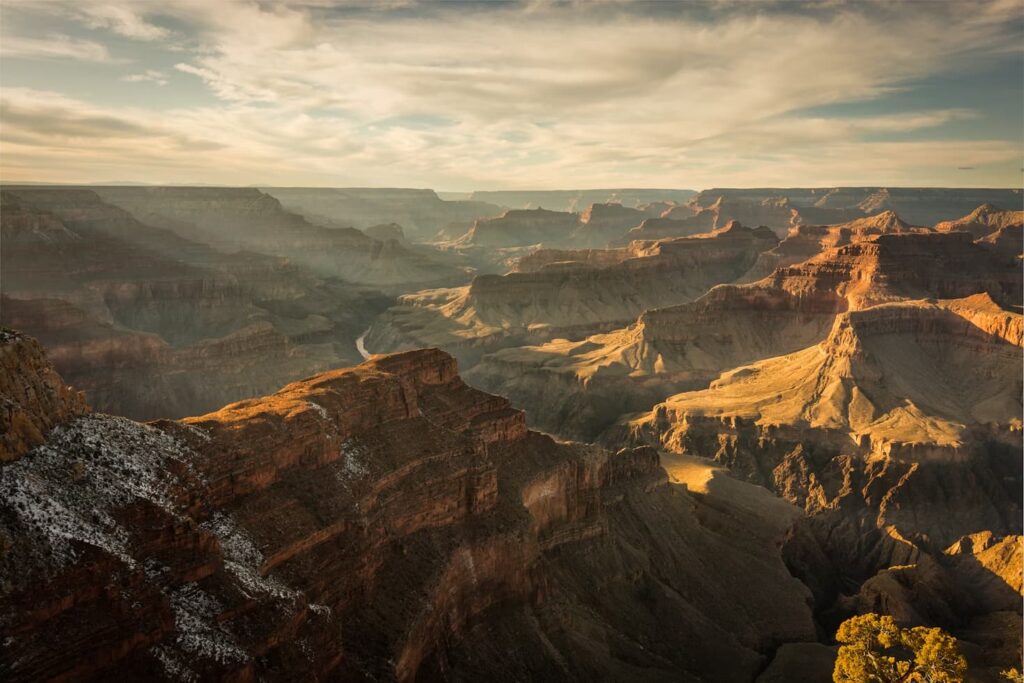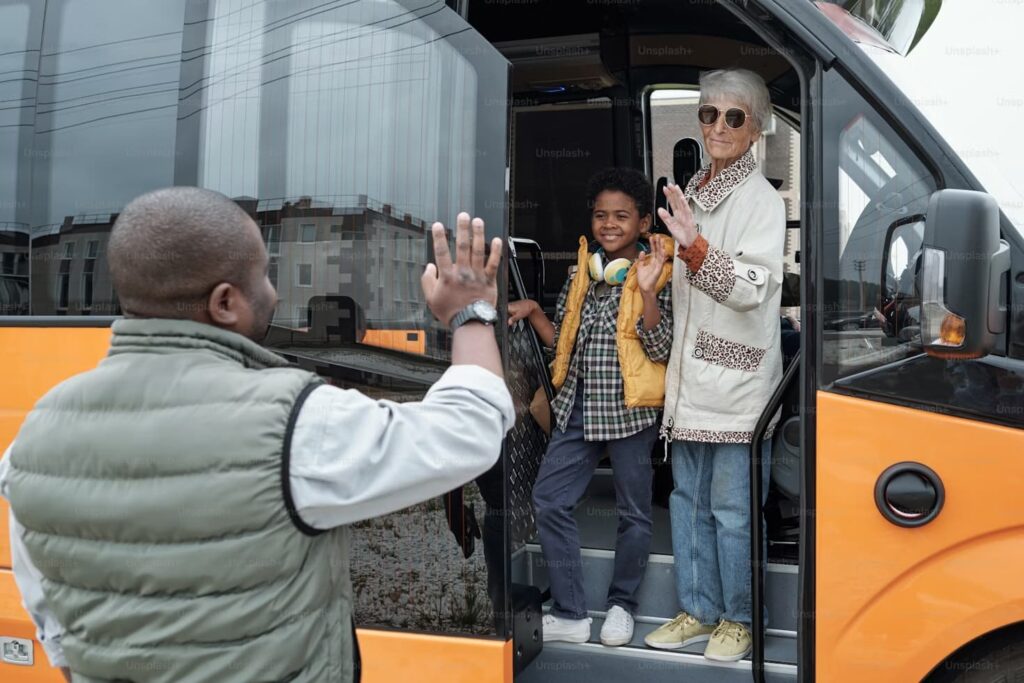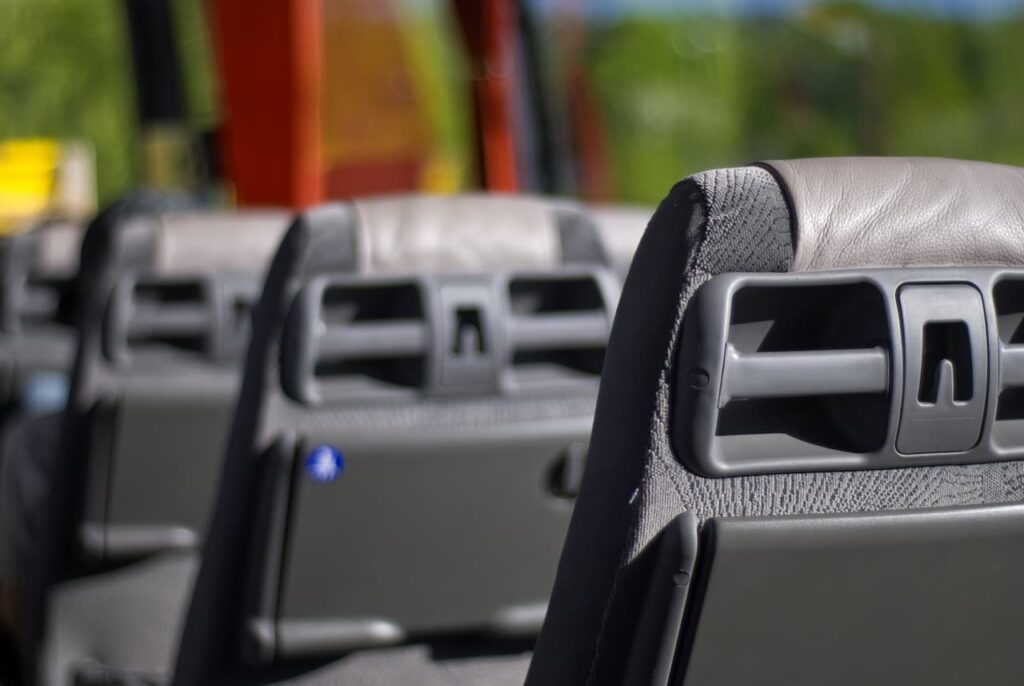The post What to See in North America by Bus appeared first on L-T@HOE_TRANS_IT.
]]>The Majestic Pacific Northwest
Seattle’s Urban Charm
Start your bus rental journey in Seattle, Washington, where you can explore the famous Pike Place Market and the Space Needle. The city offers a blend of urban attractions and natural beauty, perfect for any traveler.
Portland’s Quirky Culture
A short ride south takes you to Portland, Oregon. Known for its artsy vibe and excellent food, Portland is a city where you can easily spend a day walking through eclectic neighborhoods and enjoying local coffee shops and breweries.
The Oregon Coast
From Portland, head west to the Oregon Coast and experience the rugged cliffs, scenic vistas, and quaint coastal towns like Cannon Beach and Newport.

California Dreaming
San Francisco’s Golden Gate
No bus tour on the west coast is complete without a stop in San Francisco. The Golden Gate Bridge, Alcatraz Island, and the historic cable cars offer memorable experiences that are quintessentially Californian.
Los Angeles’ Star Power
Travel down to Los Angeles to soak in the Hollywood glamour. Visit the Walk of Fame, the Hollywood Sign, and perhaps even catch a glimpse of a celebrity.
San Diego’s Sunny Shores
Finish your California tour in San Diego, where the beautiful beaches and the famous San Diego Zoo provide a relaxing end to your southern California adventure.
The Great American Southwest
Grand Canyon National Park
One of the seven natural wonders of the world, the Grand Canyon is a must-see. Its immense size and intricate landscapes are truly breathtaking and offer plenty of hiking, photography, and sightseeing opportunities.

Monument Valley
Further east, the sandstone buttes of Monument Valley depict classic images of the American West. Known for its dramatic landscapes and rich Native American history, it’s a place where you can take stunning photos and learn about Navajo culture.
The Heart of Texas
San Antonio’s River Walk
In Texas, San Antonio’s famous River Walk offers a unique urban experience with its riverside cafes, shops, and festivals. Don’t miss the historic Alamo, a key site in Texas history.
Austin’s Live Music Scene
Austin, the state capital, is known as the “Live Music Capital of the World.” Catch a show in one of the many bars or during a city-wide music festival.
The Historic East Coast
Washington D.C.’s Monuments and Museums
On the East Coast, Washington D.C. is packed with free museums and historic sites. The Smithsonian museums, the Lincoln Memorial, and the Capitol are just a few key highlights.
New York City’s Endless Attractions
Further north, New York City awaits with its bustling streets, Broadway shows, and landmarks like the Statue of Liberty and Central Park.
Boston’s Colonial History
Finish your East Coast tour in Boston, where historic sites from the American Revolution, like the Freedom Trail and Boston Tea Party Ships, offer a glimpse into the nation’s founding.
Tips for Bus Travel in North America
- Plan Ahead: Research bus routes and schedules, especially those that offer scenic views or convenient stops at major attractions.
- Pack Smart: Bring essentials for long journeys, including a travel pillow, snacks, water, and entertainment.
- Stay Flexible: Sometimes, bus schedules can change. Keeping a flexible travel plan can help you make the most of your trip.
- Use Stopovers Wisely: Use longer stops to explore cities or relax before continuing your journey.
Traveling by bus across North America allows you to see a wide range of attractions at your own pace, often with the added bonus of meeting fellow travelers. Whether it’s through rugged natural landscapes, bustling metropolitan areas, or historical sites, a bus journey offers a unique and enriching way to experience the beauty and diversity of North America.
The post What to See in North America by Bus appeared first on L-T@HOE_TRANS_IT.
]]>The post How to Travel with a Big Group in the US appeared first on L-T@HOE_TRANS_IT.
]]>Understand Your Group’s Needs
Before booking a charter bus, it’s crucial to understand the specific needs of your group. Consider the size of your group, the age range of the passengers, and any special requirements such as wheelchair access or onboard entertainment systems. Knowing these details upfront will help you choose the right bus type and amenities that will make the trip enjoyable for everyone.
Choosing the Right Charter Bus Company
When selecting a charter bus company, look for reputable providers with positive reviews and a strong safety record. It’s essential to check that they are licensed and insured. Ask about the experience of their drivers and the maintenance record of their fleet. A good company should be transparent about their services and willing to answer all your questions.
Plan Your Route and Schedule
Planning your route and schedule in advance is vital. Discuss with the charter company the most scenic or efficient routes, depending on your group’s preferences. Make sure there are ample stops scheduled for meals, restroom breaks, and to stretch legs. Being clear about your itinerary will help prevent any misunderstandings and ensure a smooth trip.
Amenities and Comfort
Modern charter buses offer a range of amenities to make your journey more comfortable. These might include Wi-Fi, power outlets, reclining seats, and onboard restrooms. Some buses also offer DVD players and mini fridges. When booking, consider what amenities your group will appreciate during the journey, especially if it’s a long trip.

Budgeting for Your Trip
The cost of renting a charter bus can vary widely depending on the size of the bus, the distance you are traveling, the time of year, and the duration of your rental. To get the best value, obtain quotes from several companies and ask about any additional fees such as for mileage, driver accommodation, or late-night driving. Don’t forget to factor in the cost of meals and any planned activities during the trip.
Communication is Key
Effective communication is essential when traveling with a big group. Ensure all group members are aware of the travel details, including departure times, pick-up points, and the itinerary. Consider using a mobile app or group chat to keep everyone updated in real-time about any changes or important information during the trip.
Safety Measures
Safety should always be a priority. Verify that the charter bus company complies with all national and state regulations. Check that they provide safety features like seat belts and first aid kits. During the journey, remind your group about the importance of following safety guidelines, especially when embarking and disembarking from the bus.
Packing Tips for Group Travel
Encourage your group to pack light to ensure there is enough space for everyone’s luggage. It’s helpful to provide a packing list that includes items like comfortable clothing, chargers, snacks, water bottles, and travel pillows. Also, consider the weather and any specific activities planned during the trip that may require special attire or equipment.
Making Memories
Finally, remember that traveling with a group is not just about reaching your destination—it’s about the experience. Plan some interactive games or onboard entertainment to keep the atmosphere lively and engage your fellow travelers. Don’t forget to take lots of photos and maybe even keep a travel journal to document your adventures!
Conclusion
Organizing a trip for a big group using a charter bus rental in the US can be a breeze with the right planning and preparation. By following these tips, you can ensure a comfortable, safe, and enjoyable travel experience that your group will remember for years to come. Enjoy your journey across the beautiful landscapes of the United States, knowing that you’ve got the logistics down to an art!
The post How to Travel with a Big Group in the US appeared first on L-T@HOE_TRANS_IT.
]]>The post The Future of Bus Transportation in the U.S. appeared first on L-T@HOE_TRANS_IT.
]]>Challenges facing the current bus transportation system
One of the main challenges facing the current bus transportation system in the U.S. is congestion and infrastructure issues. Many bus routes are slowed down or disrupted by traffic, making it difficult for buses to operate efficiently and on schedule. This can lead to frustration for passengers and can discourage people from using the bus as their primary form of transportation.
Another challenge is funding and budget constraints. Many public transit agencies, which operate bus systems, are facing budget cuts and limited resources, which can make it difficult to invest in new technologies and infrastructure improvements.
In addition, buses face competition from other forms of transportation, such as ride-hailing services and light rail systems, which can make it difficult for buses to attract and retain riders.
In addition to congestion and infrastructure issues, there are several other challenges facing the current bus transportation system in the U.S.
One of these challenges is the lack of accessibility for people with disabilities. Many buses are not equipped with features such as wheelchair ramps or audio announcements, making it difficult for people with disabilities to use the bus as a form of transportation.
Another challenge is the lack of connectivity with other modes of transportation. In many cases, bus routes do not align with train or subway systems, making it difficult for passengers to easily transfer between modes of transportation. This can be a major inconvenience for passengers and can discourage people from using the bus.
There is also the issue of safety and security on buses, which can be a concern for passengers. Incidents of crime or accidents on buses can discourage people from using the bus as a form of transportation.
Finally, there is the issue of funding and sustainability for the bus transportation system. As previously mentioned, many public transit agencies are facing budget constraints, which can make it difficult to maintain and improve the bus system. There is also the issue of rising fuel costs, which can impact the operating costs of the bus system.
Overall, there are many challenges facing the current bus transportation system in the U.S., and addressing these challenges will be essential in order to improve the future of bus transportation in the country.
Potential solutions for improving the future of bus transportation
There are a number of potential solutions that could help to improve the future of bus transportation in the U.S. One solution is the increased use of electric buses and other emerging technologies, such as smart transit systems, which can improve efficiency and reduce emissions.
Another solution is the creation of dedicated lanes and priority for buses on roads, which can help to reduce congestion and improve reliability. This could be done through the use of bus rapid transit (BRT) systems, which use dedicated lanes and other infrastructure improvements to speed up bus travel.
In addition, creative financing options, such as public-private partnerships and congestion pricing, could be used to fund improvements to the bus transportation system.
Case studies of successful bus transportation initiatives in the U.S.
There are several examples of cities and regions in the U.S. that have implemented successful initiatives to improve bus transportation. For instance, the city of Portland, Oregon has implemented a BRT system called the MAX, which has helped to improve travel times and increase ridership on the city’s bus system.
Another example is the Miami-Dade County bus system in Florida, which has invested in a fleet of electric buses and has implemented a smart transit system that uses real-time data to improve efficiency.
Conclusion
In conclusion, the future of bus transportation in the U.S. is facing a number of challenges, including congestion, funding constraints, and competition from other forms of transportation. However, by investing in new technologies, such as electric buses and smart transit systems, and implementing creative financing options, it is possible to improve the efficiency and sustainability of the bus transportation system and ensure that it remains a vital part of the transportation landscape in the U.S.
The post The Future of Bus Transportation in the U.S. appeared first on L-T@HOE_TRANS_IT.
]]>The post Buses in North America appeared first on L-T@HOE_TRANS_IT.
]]>The first bus in North America in our understanding was released in 1900 by Mack and was called the Touring Coach. It was equipped with a 4-cylinder engine, which allowed it to accelerate to 30 km / h, and a 3-speed gearbox. The bus had 27 seats, i.e. it was far from tiny. By the way, we will meet with the name of this company more than once. In general, its bus products, as well as heavy trucks, have always had an avant-garde design and a very original appearance. The first bus in excellent condition has survived to this day and is on display at the factory museum in Allentown.
Mack, 1900
In 1903, Fischer signed a contract with the London Bus Company to supply several buses for the English capital. Perhaps this fact would not have deserved our attention in the “American context”, but the design of the car was such that it was simply impossible not to dwell on it. The bus had a hybrid drive – this is at the beginning of the last century! The rear wheels were driven by a 10-horsepower electric motor (each), which was powered by a 15 kW generator. That, in turn, was driven by a 20-horsepower 4-cylinder internal combustion engine, and the batteries connected to the network between the generator and the traction motors served as an energy storage device. Due to the complexity of the design, the bus did not perform well and was returned to the United States.
The year 1910 has come. Buick, known today for its luxurious cars, has released Motor Bus – mind you, a wagon layout. Two-cylinder boxer engine with 22 hp. located in front and allowed a small bus to accelerate to 40 km / h. This 12-seat car was mainly used by hotels and train stations. But as the reader sees, she has already laid the foundation for the wagon layout.
Buick Bus, 1910
The transport company Greyhound was soon founded (1914), which today successfully competes with rail passenger transport. With the massive construction of highways on the North American continent, the possibility of transcontinental road passenger flights immediately arose, and routes were laid in such a way as to cover almost all states from East to West and from North to South. Comfortable multi-seat buses appeared with special low-frame chassis and special pneumatic shock absorbers, which provide a smooth ride much greater than rail transport could offer. Europe did not have to participate in such a competitive struggle, and America began its victorious march on wheels on asphalt. In addition, bus stations, scattered in the most unexpected places,
Modern Motor Coaches, 1927
Interestingly, Greyhound not only operated buses, but also made investments in the development of new rolling stock that met its requirements. Almost all American bus and truck manufacturers of that time participated in these developments, until the circle narrowed down to a few companies, and the emblem of the manufacturer himself, as a rule, was absent – it was replaced by the image of a greyhound. An example is the 1927 Modern Motor Coaches 26-seat bus. The buses of those years have pneumatic shock absorbers, purely American horns, routes written on the sides and, of course, a clearly visible image of the legendary greyhound.
Around the same time, buses with a stepped roof appeared in the USA (the European name “hohdecker” does not fit here). The 1925 ACF bus was one of the first such vehicles in the New World. Although the European company Gebruder Ludewig credits itself with the invention of such a body after the end (!) of the Second World War.
ACF, 1925
In the 1930s, small luxury buses on an extended passenger car chassis became popular. One of them is a 12-seater Fitzjohn Sedan-Bus built on a Chevrolet chassis for a transport company. Despite their small size, these bus-cars traveled through Alaska, the United States and Mexico. And even with such a small passenger capacity, trips across North America were very profitable and convenient. Please note that the favorite chrome and polished aluminum trim of most buses is not yet available.
Fitzjohn Sedan-Bus, 1930s
And a few more words about pre-war buses. Or rather, their design. It’s not about the original coloring, but about the sculpture of the object. Here, for example, Fitzjohn 1939. It is easy to see that the character of some surfaces was influenced by a passenger car. Yes, yes, it is light. Pay attention to the front fenders. One gets the impression that they were purely mechanically transferred to the bus body from a passenger car, and a real sculpture “appeared”. Quite a few American bus companies used this technique at that time, but this period passed rather quickly. Most likely, it was just a tribute to fashion.
Fitzjohn, 1939
A few words about the city bus. In the United States in the 20s and 30s, double-decker buses were quite common on the streets of large cities. Some firms produced them before the start of World War II. But, by and large, in the presence of a huge fleet of private cars and a rather weak development of public urban transport, the need for such cars has disappeared by itself. By the way, many American cities still do not have a developed public transport infrastructure. But, nevertheless, the most interesting designs of the city bus appeared from time to time.
New York Double Decker
For example, the articulated Twin-Coach of 1938. I would say “conditionally articulated”, since the semi-trailer of this bus did not move to the right or left in the turn, as we are used to, but only followed the terrain, swaying in a vertical plane. The life of this “misunderstanding” due to an ill-conceived concept was short-lived.

Twin Coach, 1938
The post-war GM, nicknamed the New Look, which appeared in 1960, was a purely city car, although it was often used on transit flights. The main differences of the bus were: a multi-section windshield, twin headlights, a moderate amount of polished aluminum and stainless steel, and a pair of sloping side windows between the doors. The engine was located at the rear, but experiments were carried out with a gas turbine and even with a steam engine. The bus was produced for several decades with minor changes.
GM New Look, 1960
In 1956, the Mack company, already known to us, manufactured an experimental ADS-1 city bus based on sketches by designer Alex de Szachnowski. The bus has been called “the transport of the future”. Today it is quite difficult to look at this creation without a smile, but then he made a considerable impression on the viewer. Smooth curves organized unfamiliar surfaces, bold glass patterns betrayed the originality of the designer’s thinking. In a word, ADS-1 became an event not only in the American, but also in the world bus industry. Unfortunately, the only copy built died in a fire.
The post Buses in North America appeared first on L-T@HOE_TRANS_IT.
]]>The post Megabus appeared first on L-T@HOE_TRANS_IT.
]]>On our last trip to the U.S., we used Megabus five times, traveling from New York City to Chicago with visits to Philadelphia, Washington D.C., and Cleveland. I also recommend reading the helpful post – Trip to New York by yourself (most of the article is relevant not only for the trip to New York, but to the U.S. in general).
If you plan your travel itinerary in advance, you can buy intercity tickets for less than $10 per person. The price includes one suitcase, which is checked into the luggage compartment, and one carry-on bag. All buses have a toilet, outlets for charging phones (not USB, but American outlets) and free WIFI, which in fact we only had working on one of the five buses. You can eat on the bus (of course, if you brought your own food).
An example of finding a ticket from New York to Philadelphia. The price per passenger is only $5.
Since Megabus is a low-cost carrier, it almost always picks up and drops off passengers not at bus stations, but on the street. The ticket will simply have an address like: Boarding will be on 35th Street between 7th and 8th lanes. By the way, there is no need to print out the ticket, you will just have to show it on your phone when you board the bus.
As for our experience, we had no problems with Megabus at all. All departures and arrivals were right on schedule. Fairly comfortable buses that were usually 70-80 percent full.
But unfortunately they don’t have some interesting routes, for example we couldn’t get a direct ticket from Chicago to New York, so we had to go to Cleveland, change to another carrier’s bus to Pittsburgh, and from Pittsburgh take the Megabus back to New York.
On the way between the cities, the bus makes a short stop at the rest area. The stop lasts about 15-20 minutes, which is enough time to buy coffee and eat something.
The post Megabus appeared first on L-T@HOE_TRANS_IT.
]]>The post Setra USA appeared first on L-T@HOE_TRANS_IT.
]]>After a rigorous test in the European market in 2003, the TopClass 400 was delivered to America. This time, they took the well-trodden path and offered Americans not the European version, but the US-built version that had only design similar to the European models. Otherwise it is a wider and longer 3-axle American with a Detroit Diesel 60 series engine and Allison B500R transmission.
Currently there are a lot of new manufacturers trying to break into the extremely conservative American bus market. Thus, three years ago a small city bus manufacturer Glaval announced the start of sales of the Synergy touring bus family. In 2011, Navistar did the same. The latest news was the appearance on the market of BCI Falcon. It is produced for the U.S. market by Australian company at its plant in Xiamen, China. However, so far these machines are not making a difference on the market.
The post Setra USA appeared first on L-T@HOE_TRANS_IT.
]]>The post Greyhound appeared first on L-T@HOE_TRANS_IT.
]]>Greyhound has more coverage than Megabus, but also costs more. Greyhound buses stop only at special bus stations, most often at their own stations.
The price of the ticket also includes one suitcase and one carry-on bag.
To travel with luggage, it must be checked in. This is done at the bus station at the ticket counter. There you will need to show a printed reservation for a seat on the bus, and then you will be given a ticket for the suitcase, which you will hang on it. Without this, the suitcase may not be accepted.
Unfortunately, we had an unpleasant experience with this company. We bought tickets from Washington to Cleveland, the departure was supposed to be at 12:00 at night, and the arrival at 11:15 in the afternoon. We arrived at the station a full hour in advance since it was already late evening, checked in our luggage and waited for departure. The bus was delayed and none of the employees could tell when it would appear, in general, no information from the company employees. They gave us the bus only at 2 am and it didn’t go all the way to Cleveland, but only halfway to Pittsburgh. When we got to Pittsburgh at 9 a.m., we were given tickets to a bus to Cleveland, which was supposed to leave at 1 p.m., so we could take a short walk downtown. But that bus was also delayed by two hours. As a result, we didn’t get to Cleveland until 6pm. In general, it was not the most fun part of our trip to America. Given our experience, I suggest not making very short layovers, as late buses are par for the course with these guys.
This company also has a handy smartphone app that helps you track your bus movements, especially handy if your boarding is on a passing bus.
The post Greyhound appeared first on L-T@HOE_TRANS_IT.
]]>